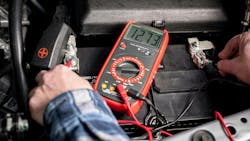Steps to prep vehicle batteries for summer
As the weather begins to warm, technicians should be keeping an eye on vehicle batteries, even beyond simply testing battery voltage. Jeff Coleman, vice president of sales for original equipment at East Penn Manufacturing, noted in a 2022 interview that the increased heat of summer months can drain a battery’s capacity and resiliency, leaving them unable to work well when winter returns.
To avoid this, batteries with thermal or heat protection measures are great, but fleets can do more to prolong their vehicle battery lives, including some of the following tips from Joy Kopcha’s piece on ModernTireDealer.com.
Charging
One of the most basic aspects of battery maintenance is ensuring that a battery is charging properly. However, the rate of charge can change with the seasons.
“Batteries accept charge and provide discharge current differently based on temperature,” said Jim O’Hara, EVP of merchandising, Clore Automotive Inc. “That’s why it can be difficult to start a car in very low temperatures, as the cold suppresses the total power capacity of a given lead acid battery.”
This means technicians need to be sure their charging equipment compensates for temperature and do what they can to cool the vehicle down prior to any battery programming.
This limitation also applies to battery jump starters of either the lead acid or lithium variety.
“We recommend increasing your charge frequency during periods of extreme temperature, though it may be necessary to allow the jump starter’s temperature to normalize a bit prior to commencing a charge sequence,” O’Hara commented. “If the jump starter is above 100 degrees F, less than zero degrees for lead acid (or less than 32 degrees for lithium), allowing it to [normalize] to room temperature is a best practice.”
Also, it’s best to charge vehicle batteries in a well-ventilated area, advised Nathan Gustafson, sales engineer at Midtronics Inc. This is due to how an overheated battery can have out-gassing vapors from the electrolyte.
Inspections
Beyond maintaining a battery’s charge, technicians should be sure to check a vehicle’s battery at least twice during winter and summer, when external temperatures are at their most extreme. This is especially true since summer heats up the engine bay, potentially accelerating battery failure onset.
Read more: Building brainier batteries
“Excessive heat causes the battery's electrolyte fluid to evaporate, weakening the state of charge,” said Ross Lopez, sales manager of new business development who specializes in batteries for GMB North America Inc. “This eventually leads to sulfation (crystals forming on the battery's plates), which prevents the battery's ability to recharge to full.”
First, be sure to check the battery’s age. There should be a sticker with the battery’s date code on the battery’s side, which indicates when it was manufactured. Lopez noted that typically, batteries should be replaced if they’re over three years old and the vehicle is experiencing starting issues.
Additionally, make sure the vehicle’s vibrations have not loosened the battery’s mounting in its compartment or tray. Check that the battery terminals are tight, do not twist around, and have no cracks, and make sure the battery case is not damaged or worn.
“Lastly, check for excessive corrosion, which will prevent the battery from receiving sufficient charge from the alternator,” Lopez explained. “Clean the corrosion with a wire brush and add an anti-corrosive spray to slow its return.”
Otherwise, battery connections with frayed wires or corrosion may experience high resistance, effecting both starting and charging circuits, Gustafson cautioned.
Testing
After a visual inspection, technicians should be sure to test their vehicle batteries as well. Haakan Light, training and development manager at Topdon USA, advised that batteries be tested upon arrival for a service visit, and then again after recharging.
“All batteries should be tested with a carbon pile load tester in addition to a standard digital battery tester, like the Topdon BT600,” Light advised.
A load test can assess if a battery can hold voltage while in use, with a weaker result indicating that the battery may fail, Lopez explained. “If the data says the battery is at 50% state of health, the unit should be replaced as soon as possible.”
But be aware that battery testers may also be sensitive to temperature, as extreme heat and cold can impact how a digital tester diagnoses a battery, O’Hara warned.
A general pre-scan of a vehicle with a 12-volt vehicle battery system is also a sound best practice, Light stated.
“Pay attention to repeat occurrences of "U codes" for communication stored in multiple modules and "battery voltage" related codes stored in multiple modules,” Light cautioned. “This may indicate a problem with the 12-volt vehicle electrical system.”

